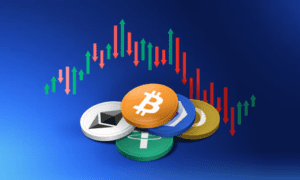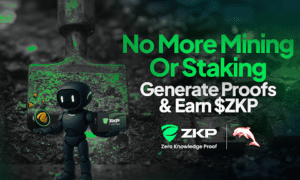Are you ready to dive into the world of cryptocurrencies? Look no further! Today, we bring to you an exciting topic that is taking the crypto market by storm – DRC-20 tokens. Whether you’re a seasoned investor or just dipping your toes into this thrilling digital universe, understanding these tokens is key to staying ahead in the game. In this blog post, we will unravel everything there is to know about DRC-20 tokens – from their origins and functionalities to their potential impact on the future of finance. So grab your favorite beverage, sit back, and get ready for a deep dive into the fascinating realm of DRC-20 tokens!
Introduction to DRC-20 tokens and their Significance in the world of cryptocurrency
DRC-20 tokens are a type of cryptocurrency token that is built on the Ethereum blockchain platform. They are essentially digital assets with monetary value that can be traded or exchanged, just like traditional currencies. However, what sets DRC-20 tokens apart from other cryptocurrencies is their unique set of rules and standards.
Significance in the World of Cryptocurrency:
The emergence of DRC-20 tokens has brought about significant changes in the world of cryptocurrency. These tokens have gained immense popularity among investors and traders due to various reasons. Some of the key factors that make DRC-20 tokens significant in the world of cryptocurrency are:
1. Smart contracts: The use of smart contracts allows for automation and self-executing transactions without the need for intermediaries. This results in faster transaction times, lower costs, and increased security.
2. Standardization: DRC-20 tokens follow a specific standard that outlines their basic functionalities and can be easily integrated into different platforms, making them compatible with various wallets, exchanges, and other tools.
3. High liquidity: Due to their standardized structure and compatibility with multiple platforms, DRC-20 tokens have high liquidity which enables easy buying and selling on exchanges.
4. Increased utility: Unlike other cryptocurrencies that serve mainly as investment vehicles, DRC-20 tokens are designed to have a specific function within their respective decentralized applications (dApps). This gives them real-world use cases beyond being mere speculative assets.
5. Reduced risk: DRC-20 tokens are built on the secure and established Ethereum blockchain, making them less prone to hacks and frauds.
6. Facilitating ICOs: Initial coin offerings (ICOs) are a popular way for new projects to raise funds by selling their native tokens. The majority of ICOs use DRC-20 tokens as they are easier and faster to create compared to building a new blockchain from scratch.
DRC-20 tokens have become an integral part of the cryptocurrency ecosystem, offering unique features and benefits that contribute to its growth and mass adoption. As more dApps and projects continue to utilize this standard, DRC-20 tokens will likely play an even more significant role in shaping the future of finance and technology.
What is a DRC-20 token and how does it differ from other types of tokens?
A DRC-20 token is a digital asset that runs on the Decentralized Autonomous Organizations (DAO) blockchain, specifically on the Dragonchain platform. It was created by Joe Roets, the founder and CEO of Dragonchain, in 2017 as a protocol for creating and managing smart contracts. The name “DRC” stands for “Dragonchain,” while “20” refers to the technical standard used for its creation.
DRC-20 tokens are also known as utility tokens, which means they have a specific purpose within the Dragonchain ecosystem. These tokens are designed to be used as incentives or rewards for developers who contribute to the development of decentralized applications (dApps) on the platform.
How Does it Differ from Other Types of Tokens?
There are several types of tokens in the cryptocurrency world, such as security tokens, utility tokens, non-fungible tokens (NFTs), and stablecoins. Each type has its own unique features and use cases. Let’s take a closer look at how DRC-20 tokens differ from these other types:
1. Security Tokens
Security tokens represent ownership rights or equity in an asset or company. They follow strict regulations set by financial authorities like the Securities and Exchange Commission (SEC) in the United States. Consequently, they require extensive legal and financial paperwork before being approved for sale.
On the other hand, DRC-20 tokens do not represent any ownership rights but instead serve as a utility within the Dragonchain ecosystem. They are not subject to securities regulations as they do not promise financial returns.
2. Utility Tokens
Similar to DRC-20 tokens, utility tokens are also designed for specific use cases within a particular platform or ecosystem. However, utility tokens can run on different blockchains, whereas DRC-20 tokens are exclusive to the Dragonchain platform.
Furthermore, utility tokens can have different technical standards depending on the blockchain they run on. For example, ERC-20 is a technical standard for utility tokens on the Ethereum blockchain, while DRC-20 is specific to Dragonchain.
3. Non-Fungible Tokens (NFTs)
NFTs are unique digital assets that cannot be exchanged for other assets since each one has its own distinct characteristics and value. They can represent digital art pieces, collectibles, or even real-world assets like real estate or vehicles.
In contrast, DRC-20 tokens are fungible, which means they can be replaced by another token of equal value without any loss in functionality.
4. Stablecoins
Stablecoins aim to maintain a stable value by pegging their price to an underlying asset or fiat currency. This stability makes them suitable for everyday transactions and as a store of value.
In comparison, DRC-20 tokens do not have a fixed value and their price is determined by supply and demand on exchanges. Their use case is primarily within the Dragonchain ecosystem, rather than as a means of exchange or store of value like stablecoins.
How do DRC-20 tokens work? A deep dive into their technical aspects
DRC-20 tokens, also known as Dragonchain tokens, are a type of cryptocurrency built on the Dragonchain blockchain platform. They were created by the team behind the Dragonchain project to facilitate secure and efficient transactions within their ecosystem. Similar to other ERC-20 tokens, DRC-20 tokens follow a set of technical standards that allow them to be traded easily on various cryptocurrency exchanges.
Here’s a deep dive into the technical aspects of how DRC-20 tokens work:
1. Smart Contracts: At its core, DRC-20 is simply a set of rules programmed in smart contracts that dictate how the token operates within the Dragonchain network. Smart contracts are self-executing agreements between two or more parties that run on the blockchain. In this case, they define how many DRC-20 tokens will be created, what their properties are, and how users can interact with them.
2. Scalable Architecture: One of the key features of DRC-20 is its scalable architecture. The token allows for dynamic scaling based on real-time demand. This means that if there is an increase in transactions within the network, more nodes will automatically join in to handle those requests without significantly affecting transaction speeds.
3. Decentralization: Another critical aspect of DRC-20 tokens is their decentralized nature. Unlike traditional centralized systems where a central authority controls all operations and user data, these digital assets operate on distributed networks without any central point of control or single point of failure.
4. Security : The underlying Dragonchain blockchain platform has multiple layers of security inbuilt to protect against external attacks and malicious activities. This makes DRC-20 tokens inherently secure, making them less prone to fraud or hacking attempts.
5. Confirmation System: Dragonchain employs a trusted confirmation system that verifies all transactions before adding them to the blockchain. This ensures the integrity of the network and ensures that only valid transactions are recorded.
6. Interoperability: Another unique feature of DRC-20 tokens is their interoperability with other chains and networks. Thanks to an interoperable protocol called “Interchain,” users can seamlessly transfer assets between different blockchains, including Ethereum, Bitcoin, and Binance Chain.
7. Low Transaction Fees: DRC-20 tokens have low transaction fees compared to traditional financial institutions because there is no intermediary involved in the process. Additionally, since the network handles a high volume of transactions simultaneously, it can handle transactions at a much lower cost than centralized systems.
8. Instant Transactions: Because DRC-20 tokens operate on a distributed network, transactions take place immediately without any delay or intermediaries involved in the process. This makes it highly efficient for users who want near-instant settlement times for their transactions.
Exploring the benefits and drawbacks of using DRC-20 tokens
DRC-20 tokens, also known as Dragonchain tokens, are a type of digital asset that run on the Dragonchain blockchain platform. Similar to other tokens like ERC-20 or TRC-20, they have specific functionalities and use cases within their respective ecosystems. In this section, we will dive deeper into the benefits and drawbacks of using DRC-20 tokens.
Benefits:
1. Interoperability: One of the biggest advantages of DRC-20 tokens is their interoperability with other blockchain platforms. This means that these tokens can be easily transferred between different blockchains without any restrictions or limitations. This opens up a world of possibilities for businesses looking to integrate blockchain technology into their operations.
2. Customization: DRC-20 tokens offer a high level of customization and flexibility for developers. They can design their own unique features and functionality based on their project’s needs. This makes it easier to build decentralized applications (dApps) that cater to specific use cases.
3. Low transaction fees: Unlike traditional financial systems, transactions involving DRC-20 tokens incur much lower transaction fees due to the absence of intermediaries like banks or payment processors. This makes it an attractive option for businesses looking to reduce costs associated with transactions.
4. Trustless system: Being built on a blockchain platform, DRC-20 tokens operate in a trustless environment where all transactions are verified and recorded on an immutable ledger. This eliminates the need for third-party intermediaries, making transactions more transparent and secure.
5. Increased liquidity: DRC-20 tokens are easily tradable on cryptocurrency exchanges, making them highly liquid assets. This ensures that holders of these tokens have the flexibility to buy, sell, or trade them as they wish.
Drawbacks:
1. Technical complexity: Building and deploying a dApp using DRC-20 tokens requires a certain level of technical expertise and knowledge of blockchain technology. This can be a barrier for businesses who do not have the necessary resources or skills.
2. Volatility: As with most cryptocurrencies, DRC-20 tokens are prone to volatility in their value due to market forces and speculation. This can pose a risk for businesses looking to utilize these tokens as a form of payment or investment.
3. Regulatory uncertainty: The regulatory landscape around DRC-20 tokens and other cryptocurrencies is still uncertain in many countries. This lack of clear guidelines or regulations can create challenges for businesses and individuals looking to use these tokens.
4. Security risks: While blockchain technology provides security through decentralization, there is still a risk of hacking or theft associated with any digital asset, including DRC-20 tokens. Businesses must take proper precautions to protect their token holdings.
Real-world examples of successful projects utilizing DRC-20 tokens
Real-world examples provide powerful evidence of the success and practicality of DRC-20 tokens. This section will explore several case studies of successful projects that have implemented DRC-20 tokens, highlighting their use cases and benefits.
1. Binance Coin (BNB)
One of the most notable examples of a successful project utilizing DRC-20 tokens is Binance Coin (BNB). Launched in 2017 by the popular cryptocurrency exchange Binance, BNB serves as the native token for the platform. It was created to fuel transactions on the exchange, providing users with discounted trading fees when using BNB instead of other cryptocurrencies.
Since its launch, BNB has seen tremendous growth in value and market adoption. With a finite supply of 200 million coins, it has a current market cap of over $6 billion. This success can be attributed to its utility within the Binance ecosystem, as well as its integration with various blockchain projects through partnerships and investments.
2. ChainLink (LINK)
ChainLink is another prime example of a project that has successfully utilized DRC-20 tokens to power its decentralized oracle network. In simple terms, ChainLink aims to bridge external data sources with smart contracts on different blockchain platforms.
The LINK token serves as an incentive for network participants who provide high-quality data feeds for smart contract execution. By using LINK tokens, developers can access off-chain resources without compromising trust or security.
Tips for investing in and trading DRC-20 tokens
Investing and trading in DRC-20 tokens can be an exciting venture, but it’s important to understand the market and make informed decisions before diving in. Here are some tips to help you navigate the world of DRC-20 tokens:
1. Do Your Research: Before investing or trading in any token, it’s important to research and understand its purpose, technology, team behind it, and potential risks. This is especially crucial for DRC-20 tokens as they may not have the same level of regulation and scrutiny as traditional investments.
2. Choose a Reliable Exchange: When buying or selling DRC-20 tokens, you’ll need to use a cryptocurrency exchange that supports this specific type of token. Make sure to choose a reputable and secure exchange with good liquidity so you can easily buy or sell your tokens at fair prices.
3. Keep Up With News and Updates: The value of DRC-20 tokens can often be affected by news and updates related to the project or industry they are part of. It’s important to stay up-to-date with any news that may affect the market so you can make informed decisions about when to buy or sell.
4. Utilize Technical Analysis: While fundamental analysis is important for understanding the long-term potential of a token, technical analysis can help you identify short-term trends and patterns in price movements. Learning basic techniques like candlestick chart reading can help you better time your trades.
Potential
1. Potential
DRC or Diamond Reserve Coin is a new cryptocurrency that is gaining traction in the digital currency market. But what makes it stand out from other existing cryptocurrencies? In this section, we will dive into the potential of DRC tokens and explore why it has caught the attention of investors and experts alike.
1.1 High Demand for Diamonds
One of the key factors driving the potential growth of DRC tokens is the high demand for diamonds in global markets. As one of the most coveted precious gems, diamonds have always been in high demand for various uses such as jewelry, industrial purposes, and investment portfolios. This consistent demand for diamonds coupled with limited supply provides stability to its value, making it an attractive asset for investors.
With each DRC token representing a certain value of diamonds, this creates a direct link between the cryptocurrency and this valuable commodity. This not only adds tangible worth to DRC tokens but also makes them an appealing option for those looking to diversify their investments.
1.2 Decentralized Storage System
Another aspect that sets DRC apart from other cryptocurrencies is its decentralized storage system. Unlike traditional methods of diamond investment where physical ownership and storage can be cumbersome and costly, DRC tokens offer a more convenient solution.
The digital nature of these tokens allows for secure storage without requiring any physical space or additional costs. This innovative approach also eliminates issues such as theft or loss associated with physical ownership of diamonds.
Conclusion
As a relatively new concept, DRC-20 tokens may seem complex and intimidating at first. However, we hope this article has provided you with a better understanding of what they are and how they work. With the rise of blockchain technology, these tokens have the potential to revolutionize various industries and offer unique benefits to investors. Whether you are an investor looking for new opportunities or simply curious about this emerging trend, it is important to stay informed and educated on DRC-20 tokens as they continue to gain traction in the market.



































